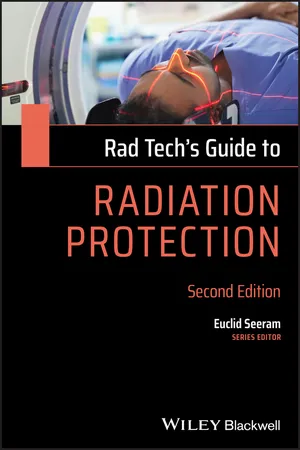
- English
- ePUB (mobile friendly)
- Available on iOS & Android
Rad Tech's Guide to Radiation Protection
About this book
Radiation protection is a core element of radiologic technology programmes and daily practice alike. Rad Tech's Guide to Radiation Protection is a comprehensive yet compact guide designed to illuminate the extensive field of radiation protection for technologists, trainees, and radiology students. Organised into ten digestible chapters, the second edition of this popular book provides new discussions of dose factors in computed tomography, the debate concerning the use of the LNT model, Diagnostic Reference Levels (DRLs), dose optimization, and more.
Written by a recognised expert in medical radiation sciences, this valuable guide:
- Helps students and technologists acquire the skills required to protect patients, personnel, and members of the public in the radiology department
- Reflects the most current standards for radiation protection, with references to relevant organisations and resources
- Covers basic radiobiology, sources of radiation exposure, dose management regulations and optimization, and more
- Presents essential information in a bulleted, easy-to-reference format
Rad Tech's Guide to Radiation Protection is a must-have resource for student radiographers and radiology technologists, particularly those preparing for the American Registry of Radiation Technologist (ARRT) exams.
Frequently asked questions
- Essential is ideal for learners and professionals who enjoy exploring a wide range of subjects. Access the Essential Library with 800,000+ trusted titles and best-sellers across business, personal growth, and the humanities. Includes unlimited reading time and Standard Read Aloud voice.
- Complete: Perfect for advanced learners and researchers needing full, unrestricted access. Unlock 1.4M+ books across hundreds of subjects, including academic and specialized titles. The Complete Plan also includes advanced features like Premium Read Aloud and Research Assistant.
Please note we cannot support devices running on iOS 13 and Android 7 or earlier. Learn more about using the app.
Information
1
Nature and Scope of Radiation Protection
What is Radiation Protection?
- Patients are exposed to varying amounts of radiation from the x‐ray tube, depending on the type of examination.
- Personnel may be exposed to radiation scattered from the patient and the equipment.
- Members of the public, in this instance, are individuals who are working or waiting in close proximity to an x‐ray room. These include, for example, radiology support staff and family members of patients.
Scope of Radiation Protection
- Physical factors. These are related to the physics of radiation, including energy dissipation in matter, characteristics of radiation, interaction of radiation with matter, and the physical and chemical factors of radiation.
- Technical factors. These include a range of topics such as technical components of imaging systems that affect dose, standards of radiation protection, dose management techniques, and shielding considerations.
- Procedural factors. These relate to personnel practices during the examination and include such tasks as equipment set‐up, patient communication and positioning, selection of technical factors, gonadal shielding, image processing, and image assessment.
- Biologic factors. The biologic effects of radiation result from the physical and chemical interaction of radiation with matter (tissue). Bioeffects can be somatic (effects that appear in the individual exposed to radiation) or they can be genetic (effects that appear in the offspring of the individual exposed). Bioeffects are now classified as stochastic and deterministic (nonstochastic) effects. These are described further in Chapter 3.
Diagnostic Radiology Modalities
Why Protect Patients and Personnel in Diagnostic Radiology?
- Biologic effects data demonstrate beyond question that radiation exposure is harmful to humans.
- Patients receive more radiation exposure from diagnostic radiology compared with any other man‐made radiation sources.
- No dose of radiation is considered safe (there is no risk‐free dose of radiation).
- Various research studies reveal that some diagnostic x‐ray examinations, particularly involving fluoroscopy and CT, deliver high doses of radiation to patients.
- Technologists assume full responsibility for all aspects of the radiographic examination, including radiation exposure of the patient. Protection of patients and operators (technologists and radiologists) depends on the technical expertise of both the technologist and the radiologist.
- Radiation safety is guided by several principles and actions set forth by the International Commission on Radiological Protection (ICRP); these are meant to keep all exposures as low as reasonably achievable (ALARA).
Framework for Radiation Protection
Table of contents
- Cover
- Table of Contents
- Preface to the Second Edition
- Acknowledgments
- 1 Nature and Scope of Radiation Protection
- 2 Diagnostic X‐Rays: Essential Physical Factors
- 3 Radiation Quantitiesand Units
- 4 Basic Radiobiology
- 5 Current Standards for Radiation Protection
- 6 Dose Factors in Digital Radiography
- 7 Dose Factors in Fluoroscopy
- 8 Factors Affecting Dose in Computed Tomography
- 9 Dose Management Regulationsand Optimization
- 10 Pregnancy: Essential Radiation Protection Considerations
- References
- Index
- End User License Agreement